The first time I witnessed Weightlifting was on the television show “Wide World of Sports.” This show aired on ABC from 1961 to 1998. I can’t recall the exact year, but it was sometime during the early 1970s that I watched Vasily Alexeyev break another world record in the clean & jerk.
Alexeev was a member of the Soviet Union weightlifting team and the most famous lifter then. In 1970, he became the first man to clean & jerk 500 pounds. I watched him compete again in the 1972 Olympics, where he won a gold medal. I saw him again a few times on television, and every time, he was breaking World Records.
I wondered what it would be like to be so powerful. Being so young and not having a weight set at home, I only had one way to test my strength level in gym class at school. The gym teacher would have us do pushups, sit-ups, pull-ups, and chin-ups, and I was usually at or near the top in these events.
I was around 12 or 13 when my mother brought home a 110-pound weight set she had purchased at a garage sale. She had my older brother in mind when she bought them, but I immediately wanted to test those weights and see how strong I was. I was also playing a lot of football then and knew that lifting weights would help me add some muscle and gain some weight.
My Weightlifting Beginnings
I started doing some clean & jerks in my basement, and it took only a short time before I could lift the 110-pound weight set overhead. My mom, who loved going to garage sales, came home with more weights for me. Soon, friends and other kids from the neighborhood joined me in the basement for clean-and-jerk competitions.
None of us knew anything about technique. We would fling the weight up to our shoulders and push the weight overhead. I found that I could lift more than the other kids my age and sometimes even more than the older kids.
During this time, a man from our neighborhood, who would go out early in the morning and drive around town to see what people were putting out by the curb for garbage collection day, started bringing me sports magazines. Among these magazines were some bodybuilding magazines.
I began looking through them and seeing pictures of the top bodybuilders of that era. Names like Sergio Olivia, Franco Columbo, and Arnold Schwarzenegger. I was fascinated by these men’s physiques and started doing many of the exercises I saw in the magazines. My parents purchased me a bench and some dumbbells for Christmas, and my little basement gym began to grow.
I was still playing Little League Baseball and playing a lot of football with my friends from the neighborhood. One day, while playing football, I injured my knee. I didn’t think it was too serious, so I continued playing, but I could tell something wasn’t right. I slept with an ice pack on my knee that night, but it didn’t help.
When I awoke in the morning, my knee had swollen like a balloon. I was rushed off to the hospital in an ambulance that a friend of my father’s drove. I spent about ten days in traction and left with a full leg cast. The only thing that saved me from surgery was my age.
I was only thirteen, and the doctor believed I could recover without surgery. Thankfully, he was right. It wasn’t long before I was playing football and lifting weights again.
As I got a little older, I got more serious about football, joining the Junior High School team. I also got more serious about lifting as I knew it would help me to gain weight, which I needed to do if I was going to keep playing football.
In my final year at North Junior High School, I won an award for best defensive player on my team. It was quite an honor because my teammates voted for it. With high school just around the corner, I stepped up my lifting.
Upon his death, my grandfather had left each of his grandchildren a little money. It came out to about $100 for each of us. I added another $30 I had saved from cutting lawns and used the money to purchase a leg extension/leg curl bench at Wonder Health Foods & Weightlifting Equipment.
I still have it today, and I think of my grandfather every time I use it.
Joining A Gym
My basement gym kept expanding until I took over the basement. I trained almost every day and even considered entering a bodybuilding competition. I eventually outgrew my basement and joined a gym for the first time. It was called A & R Gym in Belleville, NJ. It was a good gym with lots of equipment, but it eventually closed up.
From there, I joined a place similar to a YMCA, but instead of being a Christian organization, it was a Jewish organization. It was called YM-YWHA, which stands for Young Men’s and Young Women’s Hebrew Association One of our Jewish friends from the neighborhood was a member and encouraged us to join.
You didn’t have to be Jewish to join, and it was very similar to a YMCA with a swimming pool, basketball court, and a weight room. It was an excellent place to train, and most of the people who trained there were serious about their lifting.
Although I was mostly into bodybuilding at this time, I always kept my interest in the clean & jerk. Eventually, I managed to lift 200 pounds overhead in my basement, even though I knew very little about proper technique.
My older cousin was into Olympic Weightlifting and took me to a couple of contests to watch. One was the 1979 Senior National Championships at Ice World in Totowa, NJ. Ice World held some major figure skating competitions as well as some boxing events. Anyway, the lifting was pretty interesting, but I still wasn’t ready to switch from bodybuilding to Olympic Weightlifting.
Giordano's Gym
One of my friends from school had made the switch, and he encouraged me to join Giordano’s gym in Belleville. Bob Giordano and his brother were the owners, and Bob made the 1980 Olympic team. It wasn’t a big gym, but it was big enough that there was a section for Olympic lifting and an area for bodybuilding.
So I signed up for a membership and saw many of the same lifters I had seen a year before at the Senior Nationals. These were top-level lifters, some of whom had won National Championships and competed in the Olympics. I was getting more interested, but I still wasn’t ready to leave bodybuilding behind.
By my senior year in high school, I had my driver’s license, and I was always looking for part-time jobs to earn some money for gas and car insurance. A friend of my father’s sent me to a gym in Nutley, NJ. The owner of the gym, Anthony Luberto, had graduated high school with my father’s friend’s son.
So he gave me a job at the gym, which consisted mainly of ensuring all the weights were put back where they belonged and everything was in order. He gave me a little money each week, and he gave me a free membership.
One day, while working out there, I’m doing clean & jerks (once again with horrible technique). Anthony (the gym owner) sees me struggling and comes over to talk to me. He tells me to speak with Brian. “Who’s Brian, I ask?” See that guy over there in the corner doing squats with 500 pounds?
Trying Out Olympic Lifts
That’s Brian Derwin. He was a member of the 1980 Olympic team and had just returned from an international competition. I figured I had nothing to lose, so I went over and introduced myself. Brian asked if I wanted to learn how to do the Olympic lifts.
I thought about it momentarily, and I had to admit I was starting to get bored with bodybuilding. I wasn’t making the progress I had hoped for. I couldn’t seem to gain weight no matter what I did, and I never did enter a competition. My football career hadn’t gone the way I expected either.
I had gone into a bit of depression during my high school years, and it affected my ability to play the game with the same enthusiasm I once had for it. So I said yes, I do want to learn the Olympic lifts. I need a change in my life, and this might be it.
Brian told me to meet him at the Belleville High School Stadium on Monday at 6 pm. The gym is underneath the stadium, he said. I arrived a little before six and looked around for a while, trying to figure out what Brian meant by “underneath the stadium.” I walked around the stadium several times and noticed a door on the far end.
I opened the door and heard heavy weights crashing onto the wooden platform. The place was dirty and hot—picture Mickey’s gym from the movie Rocky. I was a little intimidated and thought about leaving when I heard a voice calling out to me. Are you Mark? Yes, I am I said. “Brian isn’t here yet, but he told me you’d be stopping by.
I’m Coach Bucky Cairo. Brian tells me you want to learn Olympic lifting.” Yes, I said. He sized me up and told me I had big hips (he used another word). That’s good for Olympic lifting, he said. Let’s see you do some squats, he said. I did some squats, and he said they were satisfactory.
Let’s see you do a clean & jerk. I did a clean & jerk, and he made a face that told me it was terrible. Have you ever done snatches before? He asked. No, I said. He handed me a broomstick and told me that I would learn proper technique using the broomstick in place of a barbell.
Night after night, I used that broomstick. I did squats, overhead press, and worked with the broomstick. It took a lot of patience, but I finally learned proper technique, and I competed in my first contest in December of 1981.
One problem I had during my training was that I wasn’t able to purchase a pair of weightlifting shoes. Sporting goods stores didn’t carry them, and there was no such thing as ordering merchandise through the internet in 1981. Most lifters bought their lifting shoes either at competitions or through weightlifting magazines (via US mail).
These shoes weren’t cheap either, and at nineteen years old, I didn’t have a lot of money. I did eventually order a pair through one of the magazines, but for this contest, I borrowed a pair from one of my teammates. The problem was that they were a size ten, and I wear eight and a half. I wore three pairs of socks, and they were still a little big.
My First Competition
The competition was in Vineland, NJ, which is roughly a two-hour drive. There were two sessions, one for the lighter-weight classes in the morning and one for the heavier-weight classes in the afternoon. I was in the 75-kilo weight class, which was in the morning.
But everyone else on the Belleville Barbell team was in the heavier weight classes. So, we agreed it would be easier for all of us if I gained a pound or two and moved up to the 82.5-kilo weight class. This way, we could all lift in the afternoon session.
I made sure to increase my caloric intake during the week leading up to the contest. But when I weighed in, I was underweight. Thankfully the weigh-in didn’t end for another 30 minutes. My teammates sprang into action, running around the locker room and asking the other lifters if they had any extra food for me.
I shoved about three bagels down my throat and drank about a half gallon of water. I weighed in over the 75-kilo limit, but now I had to lift with a bloated stomach and shoes that were too big.
I snatched 67.5 kg/148 lbs on my opening attempt and missed 72.5/159 twice. Since I only made one of three attempts in the snatch, my confidence was a little shaky going into the clean & jerk (my better lift).
My coach held me back a little in the clean & jerks because he felt it was important that I make all three lifts successfully. He had me open with 80/176, and then I made 85/187, and finally 90/198 on my third attempt. I was good for at least 95/209, but I couldn’t complain.
My cousin lifted in the 90-kilo class, and he made five of six lifts. We drove back home together, feeling satisfied that our first contest was behind us.
My Second Competition
My next contest was the AAU Junior Olympics in Jackson, NJ. It happened to fall on my 20th birthday. My coach wasn’t able to make it, nor was my cousin. This competition was for 20-year-olds and under, and all of my teammates were over twenty, so I’d be on my own.
Without anyone to coach me or help me out, I was pretty nervous. As I was finishing up my warm-ups in walked my teammate Tim Caso along with another teammate. Tim was a few years older than me and had been competing for a few years when I first arrived on the scene. He rode me hard in the gym and was very tough on me.
I wasn’t sure if this was the guy I wanted helping me out at my second contest, but he calmed me down and coached me through the meet. Up until that contest, I thought Tim was just a mean person, but it meant a lot to me that he was there when I needed his help, and after that, Tim was okay in my book.
I weighed in at 162 lbs. I snatched 70 kilos/154 lbs and clean & jerked 100 kilos/220 lbs. I won the silver medal in the 75-kilo weight class and drove home feeling satisfied that I had added 12.5 kilos to my total (both lifts combined).
Competing In More Contests
I don’t remember exactly what was going on in my life at that point, but I do remember that my training for the next six months was sporadic. I competed in Delaware in September. I weighed in at 158 lbs. That was eight pounds lighter than I was at my first contest nine months earlier.
I had enough trouble keeping my weight up, and the sporadic training didn’t help matters. I snatched 70 kilos and clean & jerked 95. It was disappointing, to say the least. The one bright spot was that we had a great time after the competition. My cousin, myself, our coach, and some new teammates went out to eat afterward. They had a DJ and a dance floor, and we had a blast.
My next contest was in Bayonne, NJ, at a Military Ocean Terminal Base. The US Navy used it from 1942 to 1967, and then the Army used it from 1967 to 1999.
The site is used today as a cruise port, and my wife and I took a cruise out of there about ten years ago. Anyway, back in the day, they had a weightlifting gym and a weightlifting team which was run by Coach Chris Fluelan, a Jersey City fireman. I weighed in at 163 lbs and snatched 77.5 kilos/170 lbs.
I felt happy about that because it was a 7.5-kilo increase from my previous best and my first time snatching above body weight. But my clean & jerk remained at 100 kilos. I won a trophy for second place in my weight class. My cousin lifted in this meet too, and we made friends with a couple of other lifters whom we went out to lunch with afterward.
My next competition was in Rego Park, New York, which is in Queens. It was my first time lifting at Lost Battalion Hall. The building, which was acquired in 1960 by New York City Parks, was named in honor of a World War I patrol that got separated from their division in France in 1918. They held off a larger German force for six days until reinforcements arrived.
They had a weightlifting team, and there was also a boxing ring. On the second floor was a full basketball court, which, unbeknownst to me at the time, was where the New York Knicks Championship teams of 1969/70 and 1972/73 practiced.
This competition was named the “David Berger Memorial.” Berger was one of the athletes killed by terrorists at the 1972 Olympic Games. I remember watching those Olympics on TV, and like everyone else, I remember how shocking and tragic it was.
Some of the lifters and officials at this competition had known and even trained with David since he had lived in Queens while attending college. I competed in this memorial meet seven years in a row and always considered it an honor to take part in it.
This was the same situation as my first competition, where several lifters from the Belleville Barbell team were lifting, and they were all in the heavier classes. Like before, the lighter classes were in the morning session, and the heavier classes were in the afternoon. I was once again asked to gain a few pounds so we could all lift in the afternoon.
But this time, I was a full kilo over the 75-kilo weight class, so I didn’t have to worry about shoving bagels down my throat. I snatched 80 kilos and clean & jerked 102.5 kilos. I had increased my total (both lifts combined) by five kilos. It wasn’t much, but at least it was progress. Three months later, I competed in the New York City Open.
This meet was also held at Lost Battalion Hall. I weighed in at 163 pounds. I did okay in the snatch, equaling my best with a lift of 80 kilos. But my clean & jerk decreased to 97.5 kilos. I was unhappy and discouraged with my results and vowed to train harder and more often.
Six months of hard training paid off. In November, I competed in Connecticut and weighed in at 178 lbs, eleven pounds heavier than I had ever weighed before. I snatched 87.5 kilos/193 lbs (a 7.5-kilo increase) and clean & jerked 112.5/248 (a 10-kilo increase). This competition was in a somewhat fancy hotel, and there was an open bar.
During the course of the competition, people kept buying drinks for the announcer, and it became apparent that he’d had one too many when he started slurring his words midway through the contest. Anyway, I was pleased with how I did and thought I had finally turned a corner.


More Competitions at Lost Battalion Hall
One month later, I competed again at Lost Battalion Hall. It probably wasn’t a great idea to compete two months in a row, as I took a step back. I weighed 175 lbs, snatched 82.5 kilos, and clean & jerked 112.5.
I was back at Lost Battalion Hall two months later for my second David Berger Memorial. Although I was once again having trouble keeping my body weight up, weighing in at 171 lbs, I had my best contest to date. I snatched 87.5 kilos and clean & jerked 115 kilos for a 202.5 total.
One thing I always liked about competing in Olympic Weightlifting was the camaraderie among the lifters. I developed many friendships during my eight years of competing. There was a great restaurant that was across the street from Lost Battalion and many of us would go there for a meal after the competition had ended.
Three months later, I was back again for the New York City Open. I snatched 87.5 again but increased my C & J to 117.5/259 lbs. I was happy with my C & J because I was closing in on one of my goals, which was to clean & jerk 100 lbs over my body weight, which was 170 lbs at this competition.
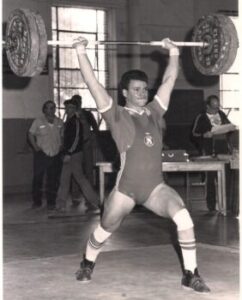
But every time it seemed like I was on my way to bigger and better things, life would get in the way. I can’t remember specifically what was happening in my life at that time, but I do remember that for the next twelve months, my training once again became sporadic. I competed four times during that period and never weighed more than 166 pounds. My best snatch was 82.5, and my best clean & jerk was 112.5.
I had been competing for a little over three years now, and I still hadn’t reached any of my goals yet. I knew if I was going to continue competing, I needed to rededicate myself and take this sport more seriously.

The Only Competition My Mother Attended
In June of 1985, I competed at the Essex Health & Racquet Club in West Orange, NJ. While my father had been to some of my competitions, this was the first and last one my mother attended.
Ever since I had injured my knee ten years earlier, she had a hard time watching me participate in any sporting event for fear that I would reinjure my knee. I was, and still am, extremely bow-legged, so I suppose that made her nervous too. She wanted to be there to show her support, but she just couldn’t watch and would cover her face whenever it was my turn to lift.
I gained most of my weight back, weighing in at 175 lbs, and snatched 90 kilos/198 lbs, my best up to that point. But I had a bad day in the clean & jerk. I had hoped to lift 125 kilos/275 lbs, but I made only my opening attempt with 115 kilos/253 lbs. I remember feeling very frustrated and disappointed about that.
One month later, at the Garden State Games, I weighed in at 181 lbs, the heaviest I ever weighed in at up to that point. But I should have learned my lesson about competing two months in a row. It didn’t go well the last time I tried it, and it didn’t go well this time either. I made only my opening attempts, 82.5 snatch, and 115 clean & jerk.
In October, I was back at Lost Battalion Hall competing in the Big Apple Open. I weighed 178 lbs and lifted terribly. I snatched 82.5 and made only 110 in the clean & jerk. I had been competing for almost four years now and still hadn’t reached any of my goals.
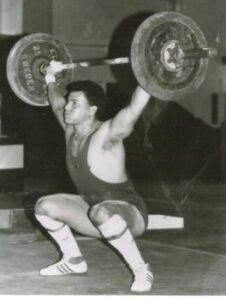
My first goal was to snatch over 200 lbs, and my second goal was to clean & jerk 100 pounds over body weight. I wasn’t even close, and I was starting to think maybe I was just wasting my time.
But in spite of not being “a natural,” I did like being an Olympic lifter, and I didn’t want to quit. I didn’t know what I could do to reach my goals except train harder and more often.
Competing In 1986
I competed in January 1986 at 177 pounds body weight and snatched 90/198. I attempted 95/209 but was unsuccessful. I did well in the clean & jerk with a lift of 125/275 (98 lbs over body weight.) My goals were finally in sight.
One month later, at the David Berger Memorial, I weighed 177 pounds and finally reached one of my goals with a 92.5/204 snatch. I did 122.5/270 in the clean & jerk. I attempted 127.5/281 but missed it. I vowed I would make it next time.
Three months later, at the New York City Open, I finally reached my goal of lifting 100 pounds over body weight. I didn’t have a good day in the snatch, making only my opener of 85 kilos/187, but I clean & jerked 127.5/281 and only weighed 80 kilos/176 lbs. So, I lifted 105 lbs over body weight. I was very happy about that and celebrated at that restaurant across the street with my training partners.
At the Garden State Games in July, I snatched 90 kilos and cleaned & jerked 130 kilos/286 pounds. I was getting close to a 300-pound C&J, and I was determined to achieve it.
In October, I competed at the Big Apple Open at Lost Battalion Hall. I had competed there so many times that I felt very much at home. I weighed in at 188 pounds and had my best competition to date. I snatched 95 kilos/209 lbs and clean & jerked 137.5 kilos/303 lbs.
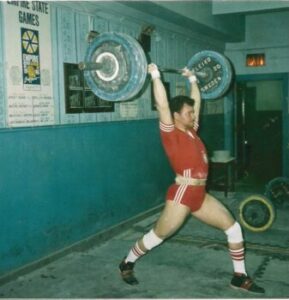
First Time Over 300 lbs (Clean & Jerk)
It was the most weight I had ever snatched and the first time I ever lifted 300 or more pounds in the clean & jerk. There was no celebration at the restaurant this time because none of my teammates lifted in this meet, but I remember feeling very satisfied and happy about my performance.
I also remember driving home and seeing Shea Stadium all lit up in the distance as game one of the 1986 World Series between the Mets and Red Sox was about to begin. There was electricity in the air.
It had taken me almost five years of competing to clean & jerk 303 lbs. It was a big accomplishment for me, and I was happy about it, but at the same time, I had to face the reality that I was never going to be a National caliber lifter. The top four or five USA lifters in my weight class were snatching what I clean & jerked.
I wasn’t even close to qualifying for the Nationals, so I set my sights on trying to qualify for the American Championships, which was a step below the Nationals. Even that would be difficult, as my weight class (82.5 kilos/181.8 lbs) had more lifters than any other weight class.
Moving Up A Weight Class
So, now I had to decide if I should move up to the next weight class (90 kilos/198.4 lbs). At 5′ 8 1/2″, I was considered a bit tall for the 82.5 class. Most of the lifters in the 82.5 weight class are about 5′ 7″ or 5′ 6″.
I had four months until my next competition, so I increased my caloric intake and tried to get my weight up to 90 kilos, but I couldn’t get past 85 or 86 kilos no matter how hard I tried. So I decided I would stay in the 82.5 class and try my best to qualify for the American Championships.
In February of 1987, I competed three times in an effort to qualify. My best of those three meets was at the military base in Bayonne, where for the first time ever, I had to cut weight. I weighed in at the class limit of 181.8 pounds. I snatched 100 kilos/220 lbs. and clean & jerked 137.5 kilos/303 lbs. But I needed to add about another 15 kilos onto my total to qualify for the American Championships.
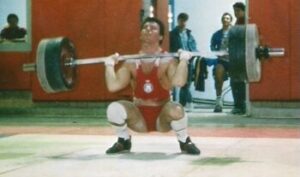

At this point, I was training extremely hard, probably overtraining. The overtraining caused a severe case of tendonitis in my knees and bursitis in my shoulder. This required cortisone shots and physical therapy. It was suggested that I take some time off from training to heal.
But I knew from past experience that this was not a possibility because every time I slacked off on training hard, I lost weight and strength. I competed five more times in 1987 but never snatched more than 100 kilos and never clean & jerked more than 137.5.
The tendonitis in my knees was getting worse, and I knew I had gone about as far as my body would take me, but nevertheless, I continued on.
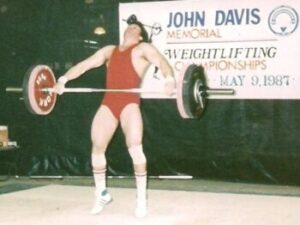

I competed in March of 1988 but didn’t do well, snatching 95 and clean & jerking 132.5. There would be no American Championships for me. My body was telling me to stop, but my mind couldn’t accept it.
In spite of the painful tendonitis in my knees, I went back to the gym and trained harder than I had ever trained before. I willed my body to lift more weight, and my body grudgingly responded.
I was doing squats with 415 pounds for five reps. I got my front squat up to 405 pounds. I split-jerked 150 kilos/330 pounds from the squat rack and cleaned 145 kilos/319 pounds. I snatched 105/231 lbs from the floor and 107.5/237 pounds from just above the knees.
I competed in May and had the best meet of my career. I weighed in at 179 pounds. I opened with 97.5/215 in the snatch and made a solid lift. I took 102.5 for my second and missed it out front. I made 102.5 on my third attempt, but it wasn’t easy. It was out front again, and I had to chase it, almost running off the lifting platform.
In the C & J, I opened with 135/297 and made it. I took 140/308 for my second attempt and cleaned it without too much difficulty, but my left knee was on fire, and I missed the jerk out front. Only one lift left to go. I was determined to fight back the pain and make this a successful lift.
I cleaned it and once again pushed the jerk out front, but I recovered quickly and got it overhead for three white lights from the judges. The 140 clean & jerk ranked me 35th out of 266 lifters in my weight class in 1988. My 242.5 total ranked me 46th out of 266.
I was happy with my results, but I knew my time as a competitive Olympic lifter was running out. I took a week off from training and competed again only seven days later. I snatched 97.5 and clean & jerked 135.
I took a break from competing for nine months to allow my body to heal. I continued to train, but I had to lower the intensity or risk surgery to my knee and shoulder.
In February 1989, I competed in the 90-kilo class, weighing in at 190 lbs. I snatched 97.5 and clean & jerked 127.5, a fairly big decrease from what I had done nine months earlier.
Knowing I could not train as intensely as I once had, which would result in my lifts decreasing, I began to lose motivation. I decided to try one last competition in July at the Garden State Games. I made only one out of six lifts and retired from competition at age 27.
I never achieved my ultimate goal of competing in the American Championships, falling 12.5 kilos/27 pounds short of the qualifying total, but I was proud of what I had accomplished. Most of what I’d accomplished was through sheer willpower and the grace of God.
I wasn’t built for Olympic Weightlifting. I’m bow-legged, have sloped shoulders, and have poor upper-body flexibility. The tendonitis I had in my knees was a terrible detriment. Would I do it all again? In a heartbeat!
Competing in weightlifting was one of the best decisions I ever made. I learned many life lessons like discipline and how to overcome adversity.
I also made some life-long friendships, and I would like to mention some of the people I had the pleasure of training with through the years. I’m sorry if I forgot to mention your name, but it’s difficult to remember everyone.
George Pjura, Mike Listro, Tim Caso, Dave Godsall, Bruce Klemens, John Hoffman, Brian Derwin, Michael Longo, John Brydon, Aleks Pyka, Jan Pyka, Bob Wentlejewski, Joe Steinfeld, Karyn Marshall, Tom Tarter, Jason Farrow, Mark Cohen, Herman Pinque, Bill McKeon, Mike Rinaldi, Rich Seibert, Perry Williams, and my cousin Bill Hall.
I also want to thank my coach, Bucky Cairo, who took the time to teach a skinny, shy kid how to lift using proper technique.

Please Share If You Liked This Article
Mark Morthier is the host of Yesterday’s Sports, a podcast dedicated to reliving memorable sports moments from his childhood days and beyond. He grew up in New Jersey just across from New York City, so many of his episodes revolve around the great sport’s teams of the 70s for the New York area.
He is also an author of No Nonsense, Old School Weight Training (Second Edition): A Guide for People with Limited Time and Running Wild: (Growing Up in the 1970s)
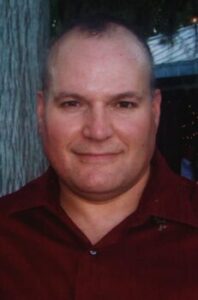
Please Note – As an Amazon Associate I earn from qualifying purchases
Resources
More From Yesterday's Sports
1972 Olympics Revisited (Weightlifting Medal Winners)
Weightlifting at the 1972 Olympics occurred in Munich, Germany, from...
Read More1968 Olympics Revisited (Weightlifting Medal Winners)
The 1968 Olympics were held in Mexico City in October....
Read More1968 Detroit Tigers (A Historic Championship Season)
With baseball season in full swing, I thought I’d take...
Read More(4 All-Time Weightlifting Greats) Paul Anderson, Tommy Kono, Ken Patera, and Naim Süleymanoğlu
Here’s a quick look at some of the accomplishments of...
Read More




